|
|
|
|
|
|
|
|
Better known for their water heaters, the Rheem company sold two of the coolest combo organs ever. Well, one combo organ, the Mark VII, and one, uhhh, "bass keyboard", the Kee Bass. They must have been pretty common, or else they hold up real well, because over the years I've seen a ton of each for sale on eBay and elsewhere.
(Many thanks to Doug Moore, original designer of the Mark VII and Kee Bass, for providing much of what follows)
Quick
Links
(Click on one to go directly to the
topic, or just scroll down and read everything!)
| History | Correspondence | Photos |
| Promo Ads | Kee Bass | Mark VII |
| Multi-Tone Booster | Carvin | Barclay |
| Volume Pedal | Schematics | Modifications |
| Sounds |
History, or "A combo organ, from Rheem? What's up with that?"
How Rheem got into the combo organ business, as told by Doug Moore:
"As far as I know, the whole thing started with a guy named Robert Metzner. He had a small import/export business, and on a trip to Japan, ran across a company that was making a continuously variable speed phonograph motor. He developed an audiophile turntable which he called the "Metzner Starlite" to be made in Japan for sale in the United States. The product was quite successful, so Bob Metzner decided to expand the operation somewhat. He sent an Ampex 600 series recorder to a company in Japan and asked what they would want to make a similar model. The results were the first Roberts recorder models, which were almost identical in appearance to the Ampex600's. These early models were vacuum tube types. In order to build transistor models, the factory in Culver City was started. Only the tape transport mechanisms were purchased from the Japanese company, and everything else was manufactured at the Bowcroft Street plant, even the fabric-covered cases. This factory became quite versatile, having a couple of expert tool and die makers, large punch presses for metal fabrication, a printed-circuit manufacturing and assembly section and a cabinet shop. Facilities were also added to manufacture small transformers and coils in house.
"At some point Bob Metzner sold off his holdings. I don't know if that was before or after the Bowcroft Street plant was in full operation. The new organization had some very savvy management, and decided to branch into other areas where they could fully utilize the capabilities they already had. They were already into school AV equipment making record players using a variation of the old Metzner motor, and tape recorders using the Japanese tape transport. They bought Califone, a manufacturer of record players and other equipment primarily intended for square dance callers. They manufactured record players under the Califone name. With the purchase of Califone they also acquired some patents for a language laboratory Califone had developed. They decided this kind of equipment would fit in with their general scheme and began to pursue this business. At this time, they had a good working relationship with Akai, the manufacturer of the tape transport mechanism. Akai had come out with some new transistor models on their own, and were marketing these in the US under both the Roberts name and their name.
"Meanwhile, Califone/Roberts realized that guitar amplifiers were well suited to being manufactured there, so they designed a few amplifiers and attempted to market them. They were not as successful in this pursuit as they had been with other products, because they had no one there who knew anything about the guitar amplifier market or what was really needed. At some point the existing Califone/Roberts operation was purchased by Rheem. I don't know any of the details of this, except now the company became Rheem/Califone/Roberts. All the old staff were retained including the managers. A couple of new managers were added. One of the new managers claimed to know something about the music industry. He convinced the other managers that the new company should pursue the music business by making products under the Rheem name. They could start with the guitar amplifiers which were already in production. Based on their success with importing, they could have other products made in Japan for distribution and sale by Rheem out of the Bowcroft St. facility. It was at this point that I became involved with Rheem/Califone/Roberts. I was hired by the Chief Engineer, not by management. I had been hired to design a new line of guitar amplifiers. I took on this job with a passion..." " I got kind of a reputation as I had "pickers" coming and going into engineering to test concepts. My theory was that nobody knows better what they want in a product than the people that use them. Thus, the new Rheem guitar amps were really designed by guitarists - all I had to do was translate their language into engineering language. It wasn't easy but it sure was fun. :-) Example: Translate into engineering criteria this sentence, "Hey dude you gots da twang OK but youse needs mo' funk." The new manager of the Musical Instruments department naturally kept a close eye on what I was doing, and figured it was in his domain. He had a couple of Japanese companies build him samples of a "Combo Organ" he wanted to market, but what he received was far short of his expectations. He tried to involve me in the project, but the Chief Engineer would have none of it. We were almost finished with the guitar amplifier designs, which were quite radical, and he didn't want to see my efforts diverted. I was, however, very interested in the organ project, and wanted to get involved somehow. I had become friends with the General Manager of the company, who was a Radio Amateur and organ hobbyist. I had a talk with him about my dilemma, and he suggested I take the prototypes home and use the parts to construct something closer to what I and the Musical Instrument manager thought we wanted. He said Art, (The Chief Engineer.) couldn't object to this. Pitney, (The General Manager.) was also very interested in my ideas for future musical products, and said that if the first products were successful even slightly, it might open the way for some kind of research program. This was all I needed so after talking it over with the others involved, I took the three prototypes home and built what became the Rheem Mark VII organ. I also showed them a prototype of a pedal bass instrument I had designed before I came there, intended to be placed under a piano. This design became the Kee Bass, though this was not what I intended. Under the Rheem name, they also imported some guitars, which were not very good quality.
"The promised research program did materialize, and for about a year I had a free hand in the development of some new products, unhampered by the demands of either Management or Engineering. I brought in one of my friends and together we developed a new small portable organ that could be manufactured at the Rheem plant in the USA and still make a profit. We also developed a rhythm box whose design was later stolen, and an all electronic piano. There were many breakthrough ideas in all of these instruments, but unfortunately before they became reality Mr.. Pitney, the General Manager, was killed in a small plane crash. He had been the one that went to bat for the musical instrument development plan, and with him gone it just all fell apart. Before I left, the whole operation had been sold again to a conglomerate called City Investing, and the Rheem name had been dropped.
Why do the Rheem organs resemble other Japanese organs, such as Ace Tone and Teisco?
"The actual manufacturer of the product for Rheem was Nakane Denki Co., which no longer exists. Nakane made all of the parts except the keyboards, which were made by Tahachiko, the same company that was making them for Yamaha at that time. (1966) Tahachiko no longer exists. Any resemblance of other organs to the Mark VII is probably coincidental. It could be, however, that when Rheem dropped out of the business, the same company in Japan made product using similar parts for someone else. This was not uncommon at the time. I don't know for a fact that this happened, but it is possible"
"The original prototype for the MK VII was made out of several samples that were submitted by several Japanese firms, but I do not know who they were. The original tone generator boards were apparently made by an independent company in Japan and used by several manufacturers. However, Nakane made all the boards in the MK VII including the generator boards. Since they were similar, I suspect they just copied the design they found in the prototype. A lot of this was going on in Japan at this time, so it wouldn't surprise me to find that pieces of the MK VII found their way into other Japanese products."
Also, see the Teisco page for some historical information linking Rheem to Teisco and Kawai.
In addition to the schematics and other marvelous information, Doug also provided me with a collection of actual letters sent between Rheem and the folks at Nakane. I scanned them and you can download the whole collection by clicking here: Rheem Correspondence (it's a 4.3MB ZIP file)
I read all the letters and summarized each. They're listed below in chronological order:
11-16-66: Final specs sent to Nakane
11-22-66: Nakane replies with a quote for one "set" (organ), with a projection for monthly production of 300 "sets"
12-13-66: Telegram to Nakane specifying a signal-to-noise ratio greater than 60db.
12-26-66: Letter from T Ogawa asking that delivery of samples for the "Baby Bass" be delayed
12-28-66: Letter from Nakane advising that the first three samples of the Mark VII have been air-freighted on 12/26 and 12/27. Some design difficulties, possible solutions and suggestions are discussed.
1-5-67: Letter from Doug to Nakane specifying various technical changes and solutions to problems encountered.
1-12-67: Letter from T. Suzuki to Doug responding to his technical changes. He apologized for two of the sample organs being "lost" and eventually delivered late. He also mentions a sample of the Kee Bass (at this time, it was called a "Baby Bass") having been sent. This is the first mention of it.
3-4-67: Letter from T. Suzuki to T. Tada about the initial samples of the Kee Bass. Noting that since the 1st 100 sets of Mark VII are finished, 2nd 200 are on the assembly line, he feels that some of their engineers have time to begin on the Kee Bass samples.
3-6-67: Letter from O.X. Pitney. Design sample of Kee Bass to be completed 3/10, shipment to Japan on 3/15.
3-27-67: Letter from Doug with some engineering changes after delivery of the 1st batch of 100 Mark VII's. He mentions a showing of the Mark VII at the Los Angeles Teen Fair, where everyone who played and heard the Mark VII preferred it to any other combo organ on the market at the time.
6-7-67: Letter to Doug from T. Suzuki. 100 Kee Bass sets already in the warehouse, 200 more not packed yet. Circuitry change recommended by Doug. Scheduled to ship the 300 out on 6/15, but will delay if change is required on all 300. Suzuki suggested changing tab wording for Percussion and Sustain to Perc and Sust
7-1-67: Letter from T. Suzuki to Doug about oscillator temperature compensation and drift in the Kee Bass
1-20-68: Letter from T. Suzuki to Doug acknowledging receipt of IC for use in production of a new 49-key organ. He includes some mathematical formulae, analyzing the filter characteristics of the Mark VII.
Doug also provided a few photos, below:
The ad on the left was from a November, 1967 issue of Music Trades magazine. The two on the right were provided to me by Doug Moore. From the notation in the lower-left corner, I would presume these were from 1968. Note that the instruments pictured were not production models. Differences noted:
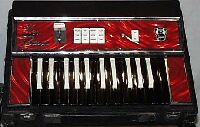 |
Not really a combo organ, but just too neat to pass up. It's only claim to fame was being used on Devo's "Whip It" video. I've been told that though it appeared in the video, it wasn't actually used on the song. Personally, I think it would have looked cooler if Ray Manzarek had had one of these atop his Continental or Gibson, though admittedly the sound can't compete with the Rhodes. |
| (Picture courtesy of the Audio Playground Synthesizer Museum) |
The Kee Bass is monophonic keyboard with high-note priority. That means it will only play one note at a time, and if you press more than one key, only the highest one sounds. This can be problematic if you play legato (not fully releasing one key before going to the next). The Sustain/Percuss tab functions like this: Switched to "Sustain", it plays like a regular organ - press a key and it sounds continuously until you release it. Switched to "Percuss", it plays like a piano. Press and hold a key, and the sound dies out; how fast depends on the setting of the Decay Slow/Fast tab. The Bass Booster, Mellow/Bright and Fuzz tabs do what you'd expect.
Tuning is accomplished via trim pots, one per key, located inside the case. The power connector is the same one used on old TV sets. Both the connector and a suitable cord can be had at www.tubesandmore.com See Parts, below for more information.
1967 List Price: $159.95
Controls:
"Star Trek Transporter-style" Bass Booster lever
Tabs: Tone Mellow/Bright, Fuzz Off/On, Mode Sustain/Percuss, Decay Slow/Fast, Power Off/On. (I got to thinking after I wrote this: I think the Transporter used slide controls, rather than levers)
Is there a Rhodes/Kee Bass connection?
In the previous incarnation of this site, I had the following quote:
"Harold Rhodes was approached by Rheem in the late fifties with a view to making some kind of bass keyboard, but each ended up making their own"
Here's what Doug Moore had to say about that:
"Regarding the connection between Fender and Rheem on the Kee Bass. I don't know how this rumor got started, and as stated on your website, it is to the best of my knowledge, false. There is one very obscure connection, which might possibly be the source of the rumor. ...before Rheem employed me, I had developed a pedal string bass instrument intended for piano players. It also had a couple of drum sounds that could be added to the bass. I took this instrument over to the Fender factory and showed it to one of their engineers. I am vague now on exactly who it was, but the name Schultz comes to mind. They were slightly interested, but said they were already producing something similar. I am not certain when this meeting took place, but 1965 is a possibility. "
The Keyboard Museum has a really cool Virtual Kee Bass! Click on the link to try it out!
I don't know anything more about these than what's shown here. I asked Doug Moore about them, and he's not aware of any production models or prototypes that looked like these. It's possible that either or both of the first two are aftermarket mods done by individuals. The third, the "Raven Piano Bass" certainly looks like a production model, but I have no more information on it or its origins
Raven Piano Bass
Doug tells me he knows nothing about the Kee Bass being marketed under a different name, but I think the pictures below prove that at some point, it must have been.
Some assorted pictures (of my own Mark VII), for your enjoyment:
Controls:
Throttle Levers: Vibrato Speed, Bass
Booster.
Tabs:
Multi-tone boost, Fuzz Bass, Solo Bass
Single Octave Bass, 2 Octave Bass, Flute, Strings, Brass, Reed, Vibrato Off/On, Tone Bright/Mellow
16', 8', 4'
Power Switch.
1967 List Price: $660
The Voice and Footage Tabs work together - the Voice tabs set the timbre, and the Footage tabs set the rank - sort of like a Vox Continental. You have to have at least one of each depressed to get any sound at all.
The Vibrato is variable from very slow to very fast. (see Vibrato demo below)
Bass Octaves
The Mark VII has a pretty versatile two-octave Bass section. Here's how it works:
With the "Solo Bass" tab Off, both bass octaves play the same voices as the rest of the keyboards, basically turning the Mark VII into a 5-octave organ. When the Solo Bass tab is on,
The Treble voices, whether from the 3 rightmost octaves, or from the 2 bass octaves, are all routed to the Main Output jack.
A separate Bass voice (a fairly mellow, but nice and bassy voice) is sent from either or both of the bass octaves to the Bass Output jack. The Fuzz Bass tab affects only this voice, and has a nice, moderately fuzzy, but not overly gritty sound.
The "Single Octave Bass" tab turns on the Bass voice for only the first (Black) octave, and the Two Octave Bass tab turns it on for both octaves. While experimenting with mine, I found that sometimes with the One octave tab off and the Two octave tab on, I got Bass output only from the grey octave. I could not reproduce this behavior consistently, however.
The Bass Booster lever is simply a volume control, and affects only the Bass voice. It's necessary because the volume pedal does not affect the Bass voice, only the Treble voice.
The Solo Bass tab, when turned on, removes the regular treble voices from the bass octaves, so they produce no sound at the Main jack, only the Bass voice at the Bass jack.
The lowest octave is monophonic on-purpose. Playing more than one note at those pitches produces undesirable beats. It's mono for the Bass voice only - for the Treble voices, it's polyphonic, just like the rest of the keyboard
Here are some good closeups of the control panel:
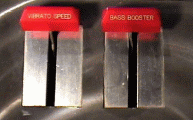

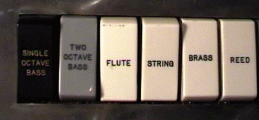
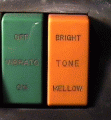


(Pictures courtesy of Raymond Richards)
Inside Pictures
(thanks to Scott Helmke for these)
Design Difficulties:
"There were a couple of problems that cropped up in production due to the specific components used. For example, the resistors used were a type where the connection to the ends was made by a couple of turns of wire. The resistors were then dipped in some kind of paint which was supposed to be a good insulator. In the tone generators, the resistors were packed tightly and flexing of the boards sometimes wore the paint off the ends of the resistors resulting in shorts. The electrolytic capacitors were not of high quality, and by now, probably most should be replaced. Lastly, the Japanese company failed to implement some of the circuitry that was on the original prototype, and there is excessive key pop on the top octave. Some key noise on audio keyed organs is unavoidable, but it can be improved on the Mark VII if one wants to go to the trouble."
Farfisa Compacts were (and still are) famous for their Multi-Tone Booster. Funny that the Mark VII had the same feature, eh? Since the Mark VII was Japanese, and the Farfisa Italian, it's unlikely they were produced by the same company. Could it be that a Multi-Tone is just a standard feature of many Combo Organs? Nahhh, read on...
Following is what I (and Barry Carson) had originally written about this feature. This will give you an idea of the thinking about it before we knew what it really did. Turns out Barry's assessment was spot-on.
MY ORIGINAL DESCRIPTION: The Multi-Tone booster is rather curious. It adds a "boosted" version of the regular voices, similar to the Farfisa Compact, but not exactly. The sound is much raspier than the regular voices (like the Farfisa) - so much so, that the "boosted" Flute voice sounds nothing like a standard Flute voice. The booster also works in conjunction with the Volume pedal, in a manner of speaking. As explained by the owners manual, the Volume pedal controls the volume of the regular voices, and the Multi-Tone Booster adds a boosted version of the voices, but at full volume. Their suggestion is that after turning the booster on, you can use the Volume pedal like a Crescendo pedal, adding the regular organ sound in varying amounts. Now, that's the impression I got reading the manual, and from my experience with a Mark VII which had NO volume pedal, and would ONLY make a sound with the Multi-Tone booster on.
BARRY'S ORIGINAL DESCRIPTION:"With the Tone tab off, the volume pedal controls the volume like usual and the organ has its full sound. With the Tone tab on, the pedal does not control the volume, it controls the tone of the organ. With the pedal all the way up, you get a thin sound, as you lower the pedal, the sound gets fuller or richer until, when the pedal is all the way down, you get the regular organ sound. So, here's a warning - if you have a Rheem without a volume pedal, you can get tricked into thinking you are getting the full sound by putting the tone tab 'on'. You are not - you are getting full volume, but not full tone, just the thinnest sound. At least, that is what mine does..."
NOW, THE REAL MULTI-TONE STORY (Straight from the horse's mouth):
"As I recall, one of the Italian combo organs [Doug was thinking, of course, of the Farfisa Compact line] had a tab of that name. Jerry, our Musical Division manager, edicted that the Mark VII should have a tab of the same name. I think the conversation went something like this:"
Jerry: "The XXX has this
control on it called Multi Tone Boost and we don't. Can we add it?"
Doug: "What does it do?"
Jerry: "I don't know, is it important?"
Doug: "Well if it's a feature that's popular in the competition,
yes, it's important."
Jerry: "We just need to have the control, it doesn't have to do the
same thing."
Doug: "Well, what do you want it to do?"
Jerry: "I don't care as long as it does something."
Doug: "How much can I spend on it?"
Jerry: "You mean there's more than just the switch?"
Doug: "Probably."
Jerry: "OK, in addition to the switch - fifty cents."
"In the real world, conversations like this take place between sales departments and engineering departments more often than anyone would be comfortable believing. :-) So I wrangled a sample of the Italian XXX model, to see what the MTB tab did. It turned out it engaged a coupler that was operated by a knee lever. The effect was to bring in the higher octaves as the lever was advanced. Obviously I couldn't do this for fifty cents.
"So what I did was this: When the MTB tab is on, the high frequencies are routed around the expression pedal with a small capacitor. The sound is "thin." As you push the expression pedal down, the low frequencies are added to the mix. At full expression, it doesn't matter whether the MTB tab is on or off. This was all I could do with the funds allowed. It wasn't totally bogus, but it had limited usefulness."
So, there you have it! A fifty-cent modification to appease the sales guy. And you thought there was some complex and mysterious circuitry involved!
Here's a clip from the schematic:
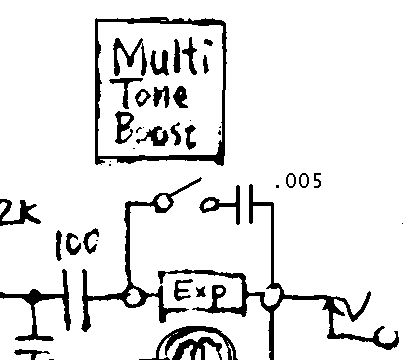
"Exp" is the volume (expression) pedal. The organ signal comes in from the left, goes through the volume pedal, and comes out the Main Output jack on the right. The Multi-Tone tab just routes the higher frequencies (just like with speaker crossovers, a capacitor acts as a high-pass filter) directly to the jack. With the volume pedal back, only the higher frequencies are sent to the output. As the pedal is pushed forward, the lower frequencies are added.
In 1969, Carvin was actually a distributor for the Mark VII. Check it out here:
http://www.carvinmuseum.com/decade/69-guitars.html
In case that link doesn't work here's what it says, along with the picture:
Note that with a List price of $660, it was probably possible to buy a Mark VII from a music store for as little as $462 (the typical 30% off attainable by most hard bargaining buyers). So Carvin's Direct price didn't represent a huge discount.
The Mark VII was also sold under the "Barclay" name. I don't have any idea what the relationship with Rheem was (and neither does Doug Moore), so what's here is pretty much all I know about it. The only difference seems to be the large nameplate on the back, and the smaller one on the top (Thanks to Tim Privitera. for these pictures)
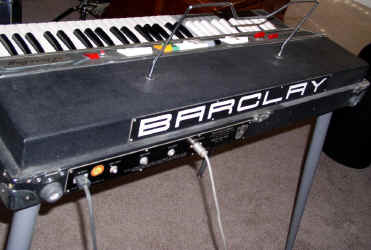 |
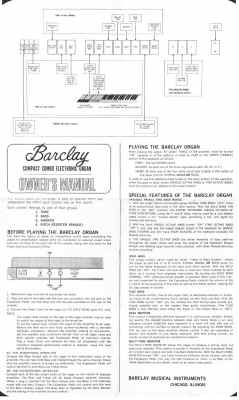 |
| Owners manual. Should be good for the Mark VII as well |
The pedal is an optical design, but the kicker is the oddball connector. It's apparently the same kind of plug used for mics on old Lafayette and Courier CB's. See my Spares & Repairs page for a source for obtaining these.
|
|
|
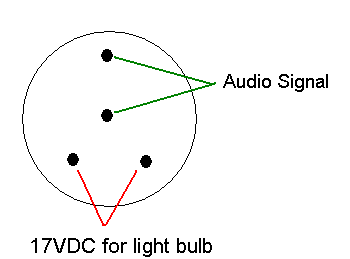 |
|
|
How to "hotwire" a Mark VII with no volume pedal |
If you connect the two Audio Signal pins together, you'll get the full, normal organ sound at the output jack. Doing this effectively disables the Multi-Tone Booster tab. When doing this, just leave the other two pins empty.
You can also connect a volume pedal to the Audio Signal pins, and retain the functionality of the Multi-Tone tab. You can use any kind of pedal you like, you just need to have the variable resistance across the two Audio Signal pins. The resistance range needs to be quite high, on the order of 1megohm, to get the full range of control. You may have to experiment a bit with different pedals/pots.
There were never any "official" schematics published for either instrument, so don't bother looking for them. I do, however, have scans available for download of the "Blueprint" for the Mark VII, and the original hand-drawn schematic for the prototype of the Kee Bass. Both are available on my Schematics page. You may also find the original patent art for the Kee Bass for sale on eBay - don't bother buying it (I think the guy is asking like $12 + shipping). Just go to the US Patent Office website, and order a copy of patent # 3,484,529 - it'll set you back a whopping three bucks!
The following modifications were suggested by Doug Moore:
Mark VII
Volume Pedal: "There were some production variations in the MK VII.... The photocells in the expression shoes were somewhat inconsistent, and there really should have been an adjustment. The minimum volume depends on the dark resistance of the cell. ...with the MTB OFF you could adjust the minimum volume by shunting the resistor that is across the output jack. (I believe it was 10K) try another 10K resistor across the jack and see if this gives you the result you want."
Multi-Tone Booster: "As for the MTB, it consists of only one capacitor, so you can piddle with the value of this, or add a resistor in series with it untill you get the kind of effect you want. It will never be spectacular, but it should be useable"
Isolate the Flute voice, improve the Bright/Mellow switch: As-designed, the Flute voice will dampen much of the higher harmonic content from the other voices. If you switch on any combination of String, Brass and Reed, you get a fairly bright voice, then if you add the Flute voice, it mellows it all out to where it sounds a lot more "flutish", instead of just adding an undertone of Flute voice. Doug has proposed a solution, but bear in mind that it has not been tested. That's not to say that it's dangerous in any way (well, no more so than any other electronic modification), just that neither he nor I can guarantee that it will fix the problem and produce a pleasing result. Another shortcoming of the design is that the Bright/Mellow tab really doesn't have a huge effect on the sound. Applying this mod should remedy that, but again, there are no guarantees. Following is Doug's assessment of the problem and his proposed solution:
"Using one filter for 7 octaves of tones is problematical. But it still can be improved a bit without drastic changes. Notice that the flute filter is a simple two section low pass RC filter. This sort of works by itself, but when you turn on the flute you end up putting that .03 capacitor right on the bus where all the tones are collected. What the whole voicing system needs is more output isolation. Even if we lose some gain doing this, the output preamp has more than enough reserve to make up for the loss. Here's what I would suggest, which will also take care of your bright/mellow problem:
"On the side of four voicing tabs that is NOT the common bus, add a resistor [clarification - one resistor for each tab], about 6800 ohms. On the BRASS and STRING you can just increase the value of the existing resistors to the closest standard value. For example on the BRASS you can substitute a 15K for the 6800, and on the STRING you can substitute an 8.2k for the existing 2k. Change the 4700 ohm resistor on the tone bright/mellow switch to 10K. In series with the .22 capacitor from the bass circuit to the preamp input, add a 6800 ohm resistor. You will then need to fire it up and readjust the overall gain via the adjustment on the back panel. Once this is done you will need to adjust the internal bass level pot for balance with the rest of the voices. I think you will find that these changes will reduce the interaction between the various sections.
"f you need more gain, my recollection is that we removed the 100mf capacitor that bypassed the emitter of the transistor that drives the filters. The reason for this was because there was too much gain. If that capacitor is not in place on your unit, you can add it. If you then end up with too much gain or some distortion, you can put a small resistor like 470 ohms to 1.5K ohms in series with the added capacitor."
Kee Bass:
Note that on the Bright one, I missed a note due to the monophonic nature of the instrument. I don't play staccato very well (Actually, I don't play very well, period). The samples are kind of quiet, so you'll need to turn your speakers up.
Mark VII:
(Note: All of the following demos are with 16', 8' and 4' tabs on)
The following demonstrate the sound of the Bass octaves
BassAndTreble Bass in left channel, Flute/String/Brass/Reed in right
FuzzBassAndTreble Fuzz Bass in left channel, Flute/String/Brass/Reed in right
BassAndTrebleMTB Bass in left channel, Flute/String/Brass/Reed MTB in right
FuzzBassAndTrebleMTB Fuzz Bass in left channel, Flute/String/Brass/Reed MTB in
right
The following demonstrate the effect of the Multi-Tone Booster:
MTBDemoFlute Flute only pedal up, gradually down to full, then back, then
turn MTB on and do same thing
MTBDEMOStringBrassReed Same with the other three voices
MTBDEMOFull Same with the all four voices
The following demonstrate the sounds of the individual voices, and all four combined. A simple C chord is played in all 5 octaves:
Flute Flute voice only
String String voice only
Brass Brass voice only
Reed Reed voice only
Full All four voices
The next one demonstrates the effect of adding the Flute voice to the other three. First, a chord is played with String, Brass and Reed voices, then Flute is added, then removed. This is repeated in two more octaves:
Vibrato: All four voices, Bright. Vibrato off, the on slow, moving to fast
Bright-Mellow switch demo: String/Brass/Reed, first switched to Mellow, then Bright, then Mellow - not a big difference, huh?